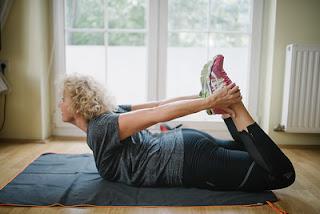
Image by Nenad Stojkovid
via Creative Commons
From 2015 to 2023, I have been experiencing problems with my right shoulder. This gave me the opportunity to visit orthopedic surgeons who referred me to physical therapists. I thought my issue was overuse at the gym since I attend a mix of 10+ classes at week at my local YMCA (strength training, stretching, cardio).
No. The problem was poor posture, caused in part by tech neck. (I am right handed, the hand I use to hold a mouse and a cell phone.)
Note: I am not a professional fitness instructor. Nor am I a licensed medical professional. This post only invites people to increase their awareness of the benefits of movement. I am sharing my experience as friends might do while having lunch toether. I strongly suggest that readers hire a personal trainer or visit a physical therapist for quality help in proper positioning and movement.
I have been practicing yoga regularly since 2004; however, I still managed to have my neck jutting out too far and my shoulder blades slumped too far forward and apart. Physical therapy helped me see how to place my upper body in better position during the many classes that I attend.
I decided to change the mix of my fitness classes so that I was doing fewer intense cardio classes and doing more classes that allowed me to maintain nearly a constant focus on my posture, particularly of my "frame," as the ballroom dancers describe it.
Yoga. I attend yoga 2 to 4 times a week. Yes, I work on positioning my feet, knees, and hips; however, I have good muscle memory with the lower half of my body. I talk to myself almost the entire time about my shoulder blades and neck.
I also adapt some poses to focus on correcting my posture.
For example, when everyone else is holding their arms strait up like the number eleven (11) with their arms resting over their ears, I frequently adapt this pose by putting my hands down by my tailbone and hold my hands together, pulling down towards to floor behind me. This is a counterpose to the slumping I often do while at the computer during my work day. I also sometimes hold up my hands in "cactus arms" and intentionally pull my shoulder blades back towards my spinal column in an attempt for them to "kiss" each other.The photo above and the video below depict posture correcting poses.
Core. I attend core classes 2 to 3 times a week. The work I do with my core muscles helps me hold myself up more upright throughout the day. When I first started the class, I was doing crunches by focusing too much on pulling my neck and chin up. My instructor helped me fix my focus to moving my shoulders towards my hips in a way that focused on my upper rib cage and my navel. One I moved the work to my torso, the pain in my neck disappeared. It made total sense, but I had been doing sit ups and crunches incorrectly for decades. One of my core instructors works as a physical therapist, so I got a little bonus tip from a licensed professional.
Ballet. I attend ballet-inspired dance classes 1 or 2 times a week. My YMCA offers an adaptation of ballet called Barre, trademarked by Les Mills. Ballet is arguable the dance form that works the most on lifting every part of the body to the sky. These classes also have a lot of arm movement. I must focus constantly on keeping my chin tucked and keeping my shoulder blades back and down. Nevertheless, I find great benefit from these classes. The teachers all have excellent posture. Also, some of the students took ballet for years as children and teens, so I am inspired by observing my fellow classmates maintain correct posture in and out of class.
Tai Chi. I attend 1 tai chi class a week. Years ago, I regularly attended tai chi classes in West Virginia. I had a hard time following the form, and it frustrated me. I tried tai chi again in Indiana in 2022. The instructor made it easier for me to follow the form. Tai chi involves a greater bend in the knee than other exercises. Like core classes, it focuses a lot of energy in the core, or the site of life force or "chi." Tai chi is also called "moving meditation."
Because of the slower pace, I can focus more proper position of my head, neck, and shoulders as well as my hips, knees and feet. Yes, we move our arms around a lot, but the movement of my arms starts with my spine and shoulder blade, which are supported by my core. I am always very relaxed and content with life after I conclude my 60 minute tai chi class. Try it sometime! It has an even more "chill" vibe than yoga. And tai chi is great for balance as well as posture.
Whether you exercise with others in a gym or by yourself at home, I hope that you find a great mix of moves that help you correct and maintain your posture.
BONUS: Strength Training. I also focus on my posture when lifting weights. I strongly advise people to work with a personal trainer when learning how to life weights. It's easy to do some damage by having poor posture.
Related:

